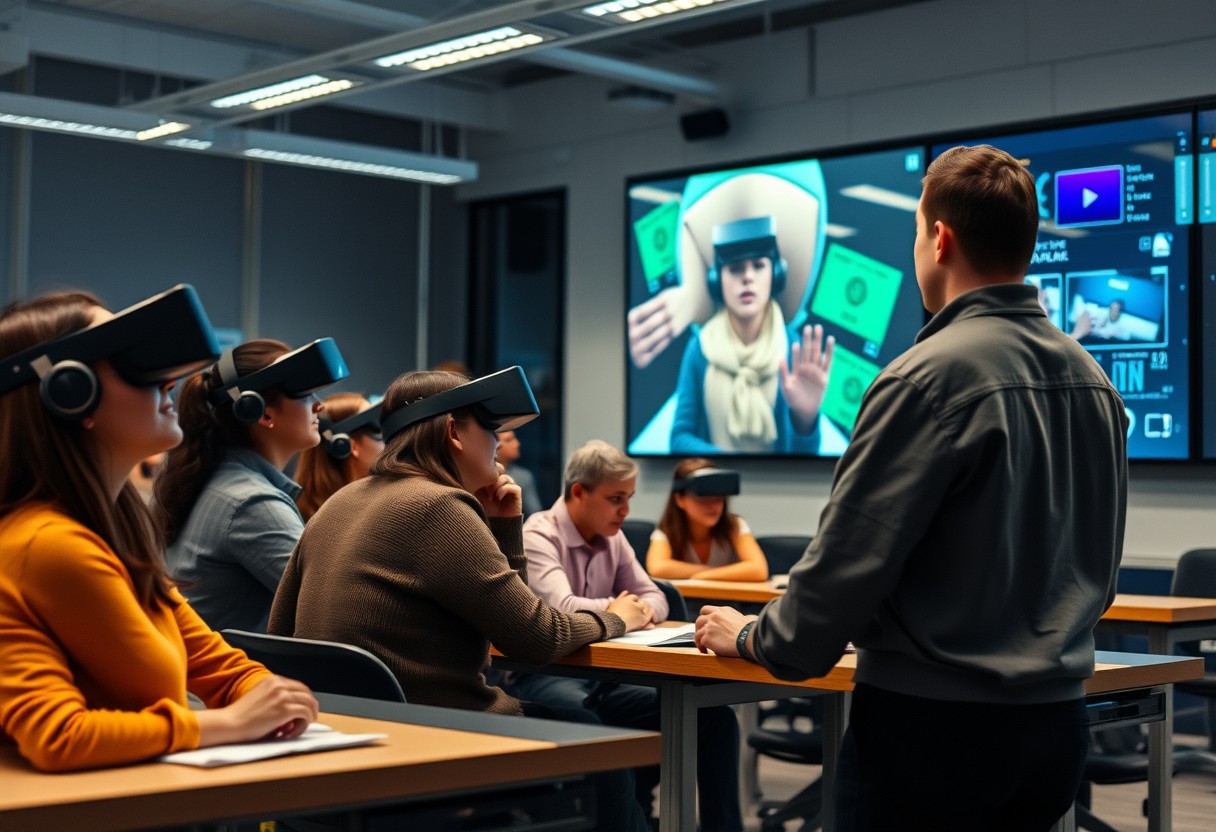AI-Based recommendation systems have revolutionized the way students learn by creating personalized learning experiences. These systems utilize advanced algorithms to analyze student data, preferences, and performance to deliver tailored recommendations for courses, study materials, and learning strategies. By leveraging big data and machine learning, AI enhances student engagement, retention, and academic success. This article explores the impact of AI in education and how it can empower students to achieve their full potential.
The Need for Personalized Learning
While traditional teaching methods have been the primary way of imparting knowledge for centuries, they come with limitations that hinder the effectiveness of education for students with varying learning styles and paces.
Limitations of Traditional Teaching Methods
Teaching methods like lectures and standardized tests often follow a one-size-fits-all approach, disregarding the diverse learning needs of students. This can result in some students falling behind due to a lack of individualized attention and support, while others may feel unchallenged and disengaged.
The Rise of AI-Based Solutions
Solutions like AI-based recommendation systems offer a promising way to address the shortcomings of traditional teaching methods by providing personalized learning experiences for students. These systems leverage data analytics and machine learning algorithms to analyze each student’s learning patterns, preferences, and areas of improvement to tailor educational content and activities accordingly. AI can determine the most effective way to present information to an individual student, whether through visual aids, interactive exercises, or additional resources based on their unique learning style, pace, and interests.
Another benefit of AI-based solutions is the ability to track student progress in real-time, allowing educators to intervene promptly when a student is struggling and provide additional support or resources to help them succeed.
How AI-Based Recommendation Systems Work
Natural Language Processing and Machine Learning Algorithms
The implementation of AI-based recommendation systems involves a combination of Natural Language Processing (NLP) and Machine Learning (ML) algorithms. NLP allows the system to understand and interpret human language, enabling it to analyze and extract relevant information from text data. ML algorithms play a crucial role in processing this data, recognizing patterns, and making predictions based on the user’s interests and behaviors.
Data Collection and Analysis
Data collection is a fundamental aspect of AI-based recommendation systems. These systems gather information from various sources, including user interactions, preferences, and feedback. Collection of large amounts of data allows the system to create detailed user profiles and generate personalized recommendations. Through Data analysis, the system can identify correlations and trends, leading to more accurate and tailored recommendations for individual users.
By leveraging advanced algorithms and vast amounts of data, AI-based recommendation systems can deliver personalized learning experiences that cater to the unique needs and preferences of each student. The ability to analyze user data in real-time enables these systems to adapt and improve recommendations continuously, ensuring that students receive relevant and engaging content to enhance their learning journey.

Identifying Student Learning Styles and Preferences
It is crucial for AI-based recommendation systems to identify and understand each student’s unique learning style and preferences. By analyzing various data points such as how students interact with learning materials, their engagement levels, and performance outcomes, AI can tailor personalized learning paths for individuals.
Behavioral Analytics and Pattern Recognition
The utilization of behavioral analytics and pattern recognition allows AI systems to identify trends and patterns in how students consume content and learn. By recognizing these patterns, AI can predict future behaviors and preferences, enabling it to recommend relevant and engaging learning materials that resonate with each student’s learning style.
Incorporating Student Feedback and Self-Assessment
To enhance personalization further, AI can incorporate real-time feedback from students and encourage self-assessment. By actively involving students in the learning process, AI systems can adapt recommendations based on their input, ensuring that the content remains relevant and effective.
Self-assessment is a critical aspect of personalized learning as it empowers students to reflect on their progress, understanding, and areas for improvement. By encouraging self-assessment, AI-based recommendation systems can foster a sense of ownership and accountability in students, ultimately leading to more effective learning outcomes.
Adaptive Learning Pathways
Dynamic Content Generation and Curation
Keep artificial intelligence at the forefront of creating personalized learning experiences with dynamic content generation and curation. AI-based recommendation systems can analyze a student’s learning patterns, preferences, and proficiency levels to suggest appropriate learning materials. By constantly adapting to the student’s needs, these systems ensure that the content presented is relevant, engaging, and at an appropriate difficulty level.
Real-Time Assessment and Feedback
Keep evaluating and adjusting the student’s learning journey with real-time assessment and feedback. AI algorithms can track a student’s progress, identify areas of strength and weakness, and provide immediate feedback to guide the student towards mastery. This instant feedback loop enables students to understand their performance better, make corrections promptly, and stay motivated throughout their learning process.
Adaptive learning pathways that utilize real-time assessment and feedback help students in identifying their weak areas, enabling them to focus on improving those specific skills. This tailored approach can lead to faster progress and better retention of knowledge.
Enhancing Student Engagement and Motivation
Unlike traditional one-size-fits-all educational approaches, AI-based recommendation systems have the power to personalize learning experiences for students, leading to higher engagement and motivation. By leveraging advanced algorithms, these systems can analyze students’ learning preferences, performance data, and feedback to tailor the content and learning activities to suit their individual needs.
Gamification and Incentivization Strategies
To enhance student engagement, AI-based recommendation systems can incorporate gamification elements and incentivization strategies into the learning process. By transforming educational activities into interactive games, students are motivated to participate actively, earn rewards, and track their progress in a fun and engaging manner.
Social Learning and Collaboration Tools
Collaboration is crucial for effective learning, and AI-based recommendation systems can facilitate social learning experiences through integrated collaboration tools. Students can interact with their peers, share ideas, and work together on projects in real-time, fostering a sense of community and cooperation in the virtual classroom.
Furthermore, these collaboration tools enable students to provide peer-to-peer feedback, engage in group discussions, and collectively solve problems, promoting a deeper understanding of the subject matter through active participation and knowledge sharing.
Motivation: AI-based recommendation systems play a crucial role in motivating students to stay on track with their learning goals. By offering personalized recommendations for additional resources, challenges, or activities based on the student’s progress and interests, these systems keep learners motivated and invested in their educational journey.
Addressing Learning Gaps and Skill Deficiencies
Identifying Knowledge Gaps and Skill Deficits
Not all students learn at the same pace or in the same way. Traditional education models often struggle to identify individual knowledge gaps and skill deficiencies that can hinder a student’s overall learning experience. This is where AI-based recommendation systems prove invaluable. By tracking and analyzing a student’s interactions with learning materials, these systems can pinpoint areas where a student is struggling or falling behind.
Targeted Interventions and Remediation Strategies
An AI-based recommendation system can then tailor personalized learning pathways to address these identified gaps and deficiencies. By offering targeted interventions such as additional practice problems, relevant reading materials, or interactive tutorials, students can receive timely and customized support to improve their understanding of the subject matter. These remediation strategies can help students catch up and progress at their own pace, ultimately leading to better academic performance and increased confidence in their abilities.
Skill deficits in key foundational concepts can have far-reaching implications for a student’s overall academic success. AI-based recommendation systems offer a proactive approach to identifying and addressing these deficits, ensuring that students receive the individualized support they need to thrive in their learning journey.
Fostering Critical Thinking and Problem-Solving Skills
For
Open-Ended Questions and Real-World Applications
, AI-based recommendation systems can personalize learning by prompting students with open-ended questions that stimulate critical thinking. By analyzing a student’s performance and preferences, the system can suggest real-world applications of the concepts being taught. This approach not only helps students understand the practical relevance of their learning but also encourages them to think critically about how to apply knowledge in different scenarios.
To
Encouraging Creativity and Innovation
, AI-powered recommendation systems can offer tailored resources and projects that challenge students to think creatively and come up with innovative solutions. By recognizing patterns in a student’s learning style and interests, these systems can suggest activities that stimulate creativity and push the boundaries of traditional learning. This personalized approach can help students develop crucial skills for the modern workforce, where creativity and innovation are highly valued.
Encouraging
Skills
Encouraging students to think creatively and innovate can have a profound impact on their overall learning experience. By challenging students to explore new ideas and experiment with different approaches, AI-based recommendation systems can help students become more adaptable and resourceful problem solvers. These systems can recommend projects and tasks that require outside-the-box thinking, pushing students to develop innovative solutions and expand their creative capacities.
Supporting Diverse Learning Needs
Accommodating Students with Disabilities
Students with disabilities often face unique challenges in traditional learning environments. AI-based recommendation systems can help address these challenges by providing personalized learning resources tailored to each student’s specific needs. For example, these systems can offer text-to-speech functionality for students with visual impairments or suggest interactive learning activities for students with cognitive disabilities. By analyzing individual learning patterns and preferences, AI can ensure that students with disabilities receive the support they need to succeed in their educational journey.
Catering to Differentiated Instruction and Learning Styles
One of the key benefits of AI-based recommendation systems is their ability to cater to differentiated instruction and learning styles. These systems can adapt learning materials to match a student’s preferred way of learning, whether they are visual, auditory, kinesthetic learners, or a combination of these. Using AI algorithms, educators can deliver personalized content that resonates with each student, promoting better engagement and comprehension of the material.
For instance, AI can recommend video tutorials for visual learners, interactive simulations for kinesthetic learners, and audio recordings for auditory learners. By leveraging these personalization capabilities, educators can create a more inclusive learning environment that caters to the diverse needs and preferences of their students.
Ensuring Data Privacy and Security
Protecting Student Data and Maintaining Confidentiality
Many AI-based recommendation systems rely on vast amounts of data to provide personalized learning experiences for students. While this can enhance the educational journey, it also raises concerns about the privacy and security of student data. It is crucial for educational institutions and edtech companies to prioritize the protection of student data and maintain confidentiality to build trust with users.
By implementing robust data encryption techniques, access controls, and anonymization processes, organizations can safeguard sensitive information and prevent unauthorized access. Regular security audits and assessments can help identify and address any vulnerabilities in the system, ensuring that student data remains secure at all times.
Compliance with Regulatory Frameworks and Standards
The compliance with regulatory frameworks and standards is necessary for AI-based recommendation systems in education to operate ethically and legally. Educational institutions must adhere to data protection laws such as the Family Educational Rights and Privacy Act (FERPA) in the United States or the General Data Protection Regulation (GDPR) in the European Union to protect student information.
Ensuring compliance with these regulations not only mitigates the risk of data breaches but also fosters a culture of transparency and accountability within the organization. By following established guidelines and best practices, institutions can demonstrate their commitment to protecting student data and upholding ethical standards in personalized learning.
Teacher Support and Professional Development
All educational stakeholders agree that the success of AI-based recommendation systems in personalized learning greatly relies on the support and professional development offered to teachers. An effective strategy involves providing training and resources for teachers to ensure they can successfully implement these technologies.
Training and Resources for Effective Implementation
An necessary component of integrating AI-based recommendation systems into classrooms is providing teachers with the necessary training and resources for effective implementation. All teachers need to understand how these systems work, how to interpret the data provided, and how to use these insights to tailor learning experiences to individual student needs. Providing clear guidance, hands-on training sessions, and access to ongoing resources is crucial for ensuring that teachers can fully leverage the capabilities of these systems to personalize learning.
Ongoing Support and Coaching
Professional development doesn’t end with initial training; support for teachers must continue over time to ensure they feel confident and competent in using AI-based recommendation systems. Continuous coaching, feedback, and opportunities for collaboration with peers can help teachers refine their skills and discover new ways to optimize the use of these tools in their classrooms. By fostering a culture of ongoing learning and improvement, schools can empower teachers to leverage AI technology effectively to personalize learning for every student.
The ongoing support provided to teachers plays a critical role in the successful implementation of AI-based recommendation systems. By offering guidance, feedback, and opportunities for collaboration, schools can help teachers overcome challenges and maximize the benefits of these tools. This continual support ensures that teachers feel equipped and motivated to embrace AI technology as a valuable asset in their educational toolkit.
Overcoming Implementation Challenges
Addressing Technical and Infrastructure Issues
After identifying the technical and infrastructure challenges in implementing AI-based recommendation systems for personalized learning, educational institutions need to strategize on how to address them efficiently. Implementation teams must ensure that the platform can handle the data load required for personalized recommendations without compromising speed and performance. This may involve upgrading servers, improving internet bandwidth, or investing in cloud computing infrastructure. Additionally, compatibility with existing systems and software integration are crucial factors to consider to ensure a seamless user experience.
Managing Change and Resistance to Adoption
Implementing AI-based recommendation systems in education requires a significant shift in traditional teaching methods and approaches. Educators, students, and parents may resist the adoption of new technologies due to fear of change, the unknown, or concerns about job security. Adoption strategies should focus on effective communication, training programs, and showcasing the benefits of personalized learning through AI. Building a support system where users can voice their concerns and receive assistance will help to minimize resistance and encourage a smoother transition.
Addressing the fear of job displacement among educators is crucial. Highlighting that AI is meant to complement and enhance teaching practices rather than replace human instructors can help overcome resistance. Providing opportunities for educators to participate in the development and implementation process of the AI systems can also boost acceptance and create a sense of ownership in the new technology.
Evaluating the Effectiveness of AI-Based Recommendation Systems
Despite the widespread use of AI-based recommendation systems in education, it is vital to evaluate their effectiveness to ensure they are enhancing personalized learning for students. Evaluation helps in refining the algorithms and optimizing the recommendations based on user feedback and outcomes.
Quantitative and Qualitative Metrics for Assessment
On a quantitative level, the effectiveness of AI-based recommendation systems can be measured by metrics such as click-through rates, engagement levels, time spent on recommended content, and learning outcomes. These metrics provide valuable insights into the impact of recommendations on student behavior and performance. Qualitative assessments, on the other hand, involve gathering feedback through surveys, interviews, and focus groups to understand the subjective experiences of students regarding the recommendations they receive.
Continuous Monitoring and Improvement
Assessment of AI-based recommendation systems should not be a one-time activity but an ongoing process. Continuous monitoring of the system’s performance allows for timely adjustments and improvements to enhance the personalization of learning experiences. By analyzing user interaction data and incorporating feedback loops, educators can ensure that the recommendations are relevant, accurate, and effective in meeting the unique needs of each student.
With regular evaluation and refinement, AI-based recommendation systems can play a pivotal role in driving student engagement, motivation, and ultimately, academic success.
Future Directions and Emerging Trends
Advancements in AI and Machine Learning
Your exploration of AI-based recommendation systems for personalized learning wouldn’t be complete without considering the advancements in AI and machine learning. Any progress in these fields could significantly enhance the capabilities of recommendation systems. Researchers and developers are continuously working on improving algorithms, enhancing data processing techniques, and integrating new technologies to make these systems smarter and more efficient.
Integrating AI with Other Educational Technologies
With the rapid growth of educational technology, the potential for integrating AI with other tools and platforms is vast. Any successful integration can lead to a more seamless and comprehensive learning experience for students. Imagine AI-powered recommendation systems working in conjunction with virtual reality simulations, gamified learning platforms, or even wearable devices to provide personalized guidance and feedback tailored to each student’s unique learning needs.
The possibilities are endless, and the future of personalized learning with AI is likely to be intertwined with a diverse array of educational technologies, creating a dynamic and adaptive ecosystem that prioritizes student success and engagement.
1. Improve student engagement and retention through personalized content recommendations.
2. Adapt learning materials based on individual preferences and progress.
3. Enhance student motivation by catering to unique learning styles.
4. Provide targeted support and resources for each student’s needs.
5. Foster a more efficient and effective learning experience for students.
6. Utilize data analytics to continuously optimize personalized learning recommendations.
Final Words
Upon reflecting on how AI-based recommendation systems can personalize learning for students, it is evident that this technology has the potential to revolutionize the education sector. By analyzing individual student data and preferences, these systems can tailor learning experiences to meet the unique needs of each student, ultimately enhancing their academic performance and engagement. As we continue to embrace AI in education, it is crucial to consider the ethics and privacy concerns associated with collecting and utilizing student data. With careful implementation and monitoring, AI-based recommendation systems have the power to transform the way students learn and succeed in their academic journey.
FAQ
Q: What are AI-based recommendation systems for personalized learning?
A: AI-based recommendation systems are algorithms that analyze data to provide personalized recommendations to users. In the context of education, these systems can suggest learning materials, courses, and strategies tailored to individual students’ needs and preferences.
Q: How do AI-based recommendation systems personalize learning for students?
A: AI-based recommendation systems personalize learning for students by collecting and analyzing data on students’ learning behaviors, preferences, and performance. By processing this data, the systems can generate recommendations that are customized to meet the specific needs of each student.
Q: What are the benefits of using AI-based recommendation systems in education?
A: The benefits of using AI-based recommendation systems in education include personalized learning experiences, improved student engagement, better learning outcomes, and more efficient use of resources for both students and educators.
Q: How do AI-based recommendation systems improve student engagement?
A: AI-based recommendation systems improve student engagement by providing relevant and personalized learning materials that capture students’ interests and motivations. This tailored approach keeps students more actively involved in the learning process.
Q: Can AI-based recommendation systems adapt to different learning styles?
A: Yes, AI-based recommendation systems can adapt to different learning styles by tracking how students interact with content and adjusting recommendations based on their individual preferences and responses. This flexibility helps accommodate diverse learning needs.
Q: Are there any challenges associated with implementing AI-based recommendation systems in education?
A: Some challenges associated with implementing AI-based recommendation systems in education include concerns about data privacy, the need for effective system training and maintenance, and ensuring that recommendations align with educational goals and values.
Q: How can educators effectively integrate AI-based recommendation systems into their teaching practices?
A: Educators can effectively integrate AI-based recommendation systems into their teaching practices by understanding how these systems work, providing input to tailor recommendations to students’ needs, monitoring students’ progress, and leveraging recommendations to enhance the learning experience.




